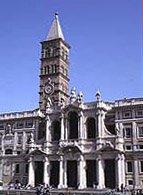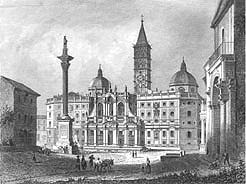The Three Great Basilicas
St. Maria Maggiore
 Rome's third most important church. One of the Four Great Basilicas. A MUST for pilgrims during a Jubilee Year.
Rome's third most important church. One of the Four Great Basilicas. A MUST for pilgrims during a Jubilee Year.
Exterior. (S.E. Back side) In Piazza dell' Esquilino is an Egyptian obelisk placed by Pope Sixtus V in 1587 AD. The back of the church has a grand staircase (leading nowhere) and two domes built in 1673. One longs to know what it looked like in the Middle Ages.
(N.W. Entrance side) Ancient fluted marble column in Piazza Santa Maria Maggiore (from the Basilica of Constantine on the Via Sacra) was topped with Virgin and Child in 1613.
Facade Loggia. 13 C mosaics started by Filippo Rosuti. This was covered (more's the pity) by Ferdinando Fuga, 1740s, with winged statues and Roman portico. The real treats in this church are inside.
Interior. Many of the earliest Christian mosaics (5 C). The nave above the arches is redolent with stories of the Old Testament.
Chancel arch (behind baldachin altar). 13 C Mosaics by Jacopo Torriti divided into 4 horizontal bands, at the top is the Virgin as a Byzantine Queen, then court scenes with baby Jesus on a jewel studded throne, two cities: Bethlehem and Jerusalem. This mosaic style is byzantine (dark lines around the figures like those in Ravenna).
Apse vault. 5 C Mosaics of birds in trees is cunningly woven together by Jacopo Torriti (1295) with his own glowing work, the Crowning of the Virgin surrounded by angels.
Floors. 12 C Cosmatesque style, ancient deep red salami porphyry disks, with green and white.
Ceiling. Started under Pope Callisto III Borgia (1455-58), uncle of Pope Alexander VI Borgia, who launched his nephew's rise to power by appointing him Cardinal-Archbishop of Valencia when the lad was 25. Five Popes later, Alexander VI (1492-1503) finished the coffered gilded ceiling with the first Peruvian gold to come from the new continent, a gift from the Spanish monarchs Ferdinando and Isabella - who a scant few years before had chased the Moors from Spain, and set Columbus up for his discovery of the New World.
13C Tomb of Cardinal Rodriguez (Right aisle facing altar). Typically gothic with angels guarding the figure in an arched ensemble.
Chapel Sistina (Right cupola facing altar). Pope Sixtus V Peretti (1585-90), an ardent builder, redecorating the old and constructing the new, asked Domenico Fontana to design this chapel as his tomb. Set in one of the twin cupolas it is a miniature church, with frescoed ceiling, and gold and marble everywhere.
Chapel Sforza (Left aisle facing altar, 1539-1602). Giacomo della Porta from the drawings of Michelangelo.
Chapel Paolina (Left cupola facing altar, 1611). Also called the Borghese Chapel. Identical in shape to its twin in the other cupola - the 17 C baroque was creeping in, and ornate decoration is getting out of hand.
 St. Maria Maggiore St. Maria MaggioreHistory 352 AD. Pope Liberius' dream of a snowstorm in August came true; he fulfilled his vow to build this church at that very place he had dreamt of. And called it Santa Maria ad Nives (nivis = snow). 432 AD. New church built by Pope Sixtus III. |
Piazza S. Maria Maggiore (Map L 5)